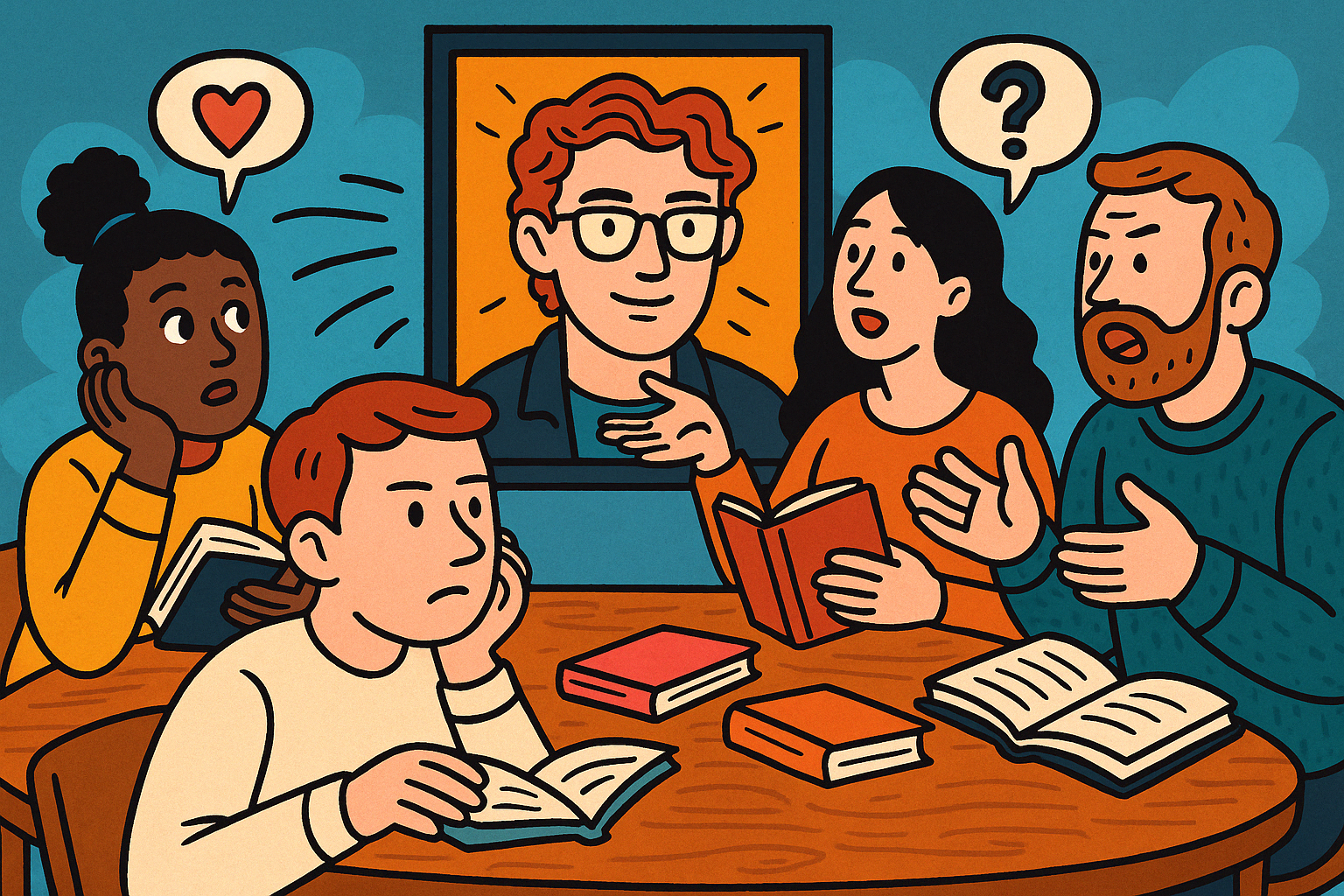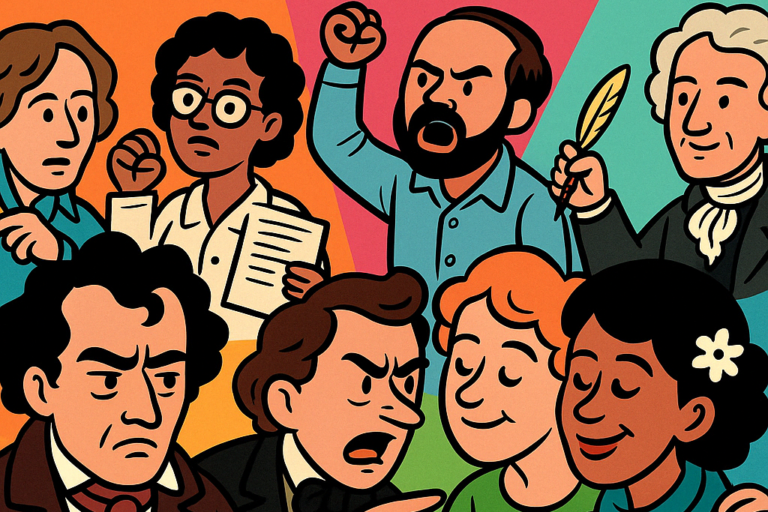What Book Club Conversations Reveal About Your Favorite Author

I didn’t expect to find so much literary insight while lurking in book club threads, but here we are. Over weeks of reading transcripts, blogs, and attending some (very passionate) book discussions, I realized something wild: book clubs are doing their own version of literary criticism—just without the jargon.
What’s more interesting is how they talk about authors as much as the books. People bring assumptions, expectations, emotional reactions, even biographical guesses—stuff that rarely shows up in formal reviews. And that’s not just reader noise; it reveals how authors are actually being read, remembered, and mythologized.
For folks like us—people who think a lot about authorial presence, narrative design, and reception—book club chatter is like finding the author’s reputation in the wild. It’s not polished, but that’s the point. It’s raw data. And there’s a lot we can learn from it.
What Readers Really Notice (That Critics Sometimes Don’t)
So here’s the thing I found both funny and kind of humbling: what sparks the most debate in book clubs is often stuff that gets just a passing mention in reviews or academic circles.
And I’m not talking about plot twists or spicy scenes—though those do get their time. I’m talking about things like emotional pacing, tone shifts, or how a character’s silence felt more powerful than the dialogue.
Take Celeste Ng, for example. Critics focus on her social commentary and clean prose, sure, but in club conversations, readers obsess over the emotional temperature of her characters—how simmering resentment or withheld affection becomes the main event.
In Little Fires Everywhere, a half-smile or a missed gesture gets more airtime than any of the “big” thematic questions.
And it’s not superficial; it’s how people are processing the deeper currents of the book.
What really caught my eye is how readers instinctively build a moral map—who’s redeemable, who’s unforgivable, and why. This is where character construction gets unpacked in real time.
For authors like Sally Rooney, whose characters are often messy and withholding, book clubs become moral courtrooms.
Some love the ambiguity; others hate the indecision. But either way, the conversation zeroes in on emotional realism in a way I rarely see in lit crit essays.
I also saw a lot of talk about authorial intent—without anyone saying “authorial intent.” Readers speculate: “Did she mean for us to feel sorry for him?” or “Was that twist a commentary on privilege, or just bad writing?”
It’s fascinating because these aren’t academic frameworks—they’re gut-level interpretations. But they still raise huge questions about narrative control and how authors guide (or mislead) reader expectations.
Another gem: tone shifts.
In Brit Bennett’s The Vanishing Half, for instance, readers latched onto how the tone evolved across generations—some felt the emotional stakes flattened as the story went on. Others thought that was intentional, a way to show distance and assimilation.
But either way, they noticed. And their read of the author shifted based on those tonal decisions.
To me, that’s the big takeaway: book club readers notice what sticks emotionally, not just intellectually. And while that may sound obvious, it’s often missing in high-level critique.
Experts (myself included) sometimes focus on structure or symbolism, and forget that the average engaged reader is building meaning from the feeling of the book just as much as the form.
That gap is worth paying attention to. Not just for understanding readers, but for understanding how authors live—or struggle—in the reader’s mind long after the book ends.
Patterns in Praise and Pushback
Once you listen to enough book club discussions (and believe me, I’ve been deep in the weeds), you start hearing the same praise points and pain points come up over and over. And that’s when it clicked for me—these are unofficial criteria for what makes an author beloved or frustrating in book club culture.
It’s less about whether a book is “good” or “bad” and more about how an author manages to show up through the work.
Below are the five qualities that almost guarantee an author gets reread, recommended, and remembered in these spaces—alongside five that trigger eye-rolls, debates, or outright rejections.
Top 5 Qualities That Elevate an Author in Book Club Culture
1. Clear but layered prose that rewards close reading
Readers love when they can read a line and just feel it hit—but then go back later and discover something new.
This came up a lot with authors like Tayari Jones and Kazuo Ishiguro. Their language is accessible, but there’s an emotional precision that invites interpretation. It’s not just pretty writing; it’s emotionally useful writing.
2. A strong narrative voice that feels personal yet complex
Think Zadie Smith, Ocean Vuong, or Jesmyn Ward. Their voices aren’t just stylistic—they feel like someone is behind the story who has lived or deeply imagined this world.
That kind of voice creates trust and keeps readers invested even when the plot slows down or shifts direction. Voice becomes the anchor, and for book clubs, that means conversation never runs dry.
3. Relevance to current social, political, or ethical debates
This is a big one. Whether it’s race, identity, climate change, or capitalism, authors who touch the pulse of now—without sounding preachy—get elevated.
Brit Bennett and Mohsin Hamid are excellent at this. Readers want to discuss big ideas, but they want them embedded in human experience, not essays.
4. Room for multiple interpretations without being vague
Clubs are most energized when different people read the same passage and come away with totally different takes.
This came up with Klara and the Sun by Ishiguro. Some read it as hopeful, others as dystopian. Either way, the book held space for discussion without collapsing under its own ambiguity. That’s gold for group dialogue.
5. The ability to “age well” over re-reads and re-discussion
Finally, authors who write books that shift in meaning when reread often rise to the top.
Toni Morrison and Marilynne Robinson are queens of this. Readers revisit their works and discover new moral, emotional, or symbolic textures each time, which makes them enduring favorites for annual or themed reading cycles.
Top 5 Criticisms That Undermine an Author’s Standing
1. Over-reliance on tropes or formulaic arcs
If book club readers feel like they’ve “read this before,” it’s game over. This came up a lot with domestic thrillers or rom-coms with familiar beats. And it’s not genre bias—it’s about feeling surprised. Even genre fans want freshness in execution.
2. Characters who feel like plot devices
Oh man, this one triggers long debates.
When characters exist just to move the story along—or worse, to prove a thematic point—readers revolt.
It happened in discussions around some recent historical fiction (no shade!), where characters were too idealized or too conveniently flawed. People want characters who behave like people, not chess pieces.
3. A perceived mismatch between ambition and execution
This one’s a killer. Readers get excited by ambitious books, but if the narrative feels like it overpromises and under-delivers, it turns into disappointment.
Think books that set up complex timelines or big twists but don’t stick the landing. Club readers remember the letdown more than the idea.
4. Didacticism that leaves no space for interpretation
Some books push a message so hard that readers feel like they’re being lectured. It’s one thing to weave in social commentary (which, again, readers love), but if it feels like a TED Talk with dialogue, the discussion dries up fast. Readers want to engage, not just nod in agreement.
5. Fatigue from repeated themes or stylistic quirks
Lastly, readers are loyal—until they’re not.
Once an author becomes known for a specific “thing” (stream-of-consciousness, shifting timelines, troubled mothers), repeated use can start to feel like a gimmick. Book clubs love to follow authors, but they also love to call them out when their latest feels like a rerun.
In short?
Book clubs build and break authorial brands. Whether you’re a writer trying to stay on readers’ shelves or an expert reader tracking literary reception, this grassroots consensus tells you what actually resonates long-term.
When the Writer Becomes the Character
So here’s something I didn’t expect when I started digging into book club discussions: how often the author becomes the subject of conversation, not just the book.
And I don’t mean “this reminds me of the author’s other work.” I mean, readers start “reading” the author as a character in the room.
There’s something wild about it—once you know a little about the writer, that knowledge starts coloring every sentence of the book.
Especially in contemporary fiction, where author interviews, Twitter threads, or even book tour clips circulate widely, readers bring that context into the conversation.
It’s not just The Book Says This, it’s She Probably Wrote That Because She Went Through XYZ.
Take Sally Rooney, for example.
Her minimalist prose and emotionally numb characters are often discussed alongside her public reluctance to do traditional promotion or speak about her private life.
In clubs, readers ask things like, “Do you think she’s just emotionally reserved, and that’s why her characters feel that way?”
Or with Ottessa Moshfegh, readers debate whether her tendency toward grotesque or unlikeable protagonists is a personal worldview or just a creative flex.
What’s happening here is that the boundary between author and text starts to blur. That’s not new, obviously—we’ve seen it in lit theory forever—but book club readers are doing it instinctively, not academically.
They’re constructing a version of the author based on the text and whatever context they’ve absorbed.
And that constructed author often becomes part of the reading experience.
Now add social media to the mix, and things really go meta.
Authors today have Instagram feeds, Substacks, podcast appearances, all of which feed the reader’s perception of who they are.
Book clubs don’t just read the book—they triangulate it with the author’s latest post. If the vibe feels aligned, it reinforces trust.
If it feels off (say, a novel about class struggle from a very visibly wealthy author), it can cause skepticism—or worse, resentment.
And then there’s the issue of intentionality.
Readers love to speculate: Was this supposed to be a metaphor? Was she writing about her own trauma?
The book becomes a kind of puzzle with the author as the missing piece. And if that author is too present or too evasive, readers notice.
It gets even more interesting with autofiction.
Authors like Rachel Cusk or Karl Ove Knausgård practically invite readers to blend the creator with the narrator.
In those cases, book clubs become both literary analysts and amateur biographers. The conversation isn’t just about craft—it’s about psychology, ethics, performance.
What this shows is that authorial presence isn’t passive—it’s part of the text’s reception. And for us, as people who study books, write about them, or teach them, that’s a huge deal.
We’re used to separating the text from the author, but readers often don’t. The cultural moment, the persona, the politics—all of it bleeds into the discussion.
So what do we do with that?
Honestly, we should be paying closer attention. These perceptions shape how books are read, shared, and remembered.
If you want to understand how literary reputation is built in real time, look at the ways book clubs talk about the author—not just the work.
So What Does This All Mean?
Look, I’m not saying book clubs are the new academic journals—but I am saying they offer a parallel, fascinating system of literary reception.
They form a kind of social feedback loop for authors—one that reveals how books actually live once they leave the writer’s hands.
And if we take them seriously (even just as data), we get a much clearer picture of not just what people are reading—but why some authors thrive in the long run.





